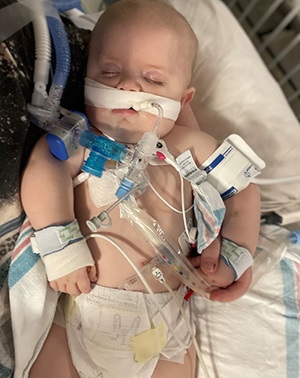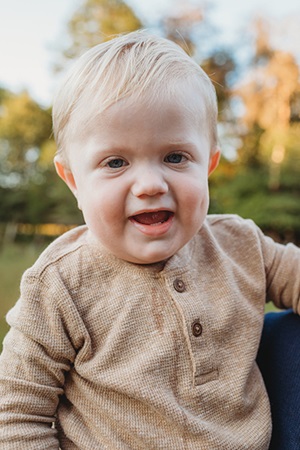 “This is not how I feel like our life is going to go,” Megan Baker remembers thinking. “Layne has a lot of people praying for him - I don’t think his quality of life is going to be bad.”
“This is not how I feel like our life is going to go,” Megan Baker remembers thinking. “Layne has a lot of people praying for him - I don’t think his quality of life is going to be bad.”
In November 2021, Megan and husband, Derek, welcomed their second baby boy, Layne. Besides being a quiet baby, nothing seemed out of the ordinary until Layne was 2 months old. He started showing mysterious symptoms, like episodes of going limp and pale and staring off into space, and he stopped gaining weight.
Within 48 hours, the Bakers went from sitting in their pediatrician’s office to being transported by ambulance to Atrium Health Levine Children’s Brenner Children’s Hospital in Winston-Salem, North Carolina. From there, Layne had two long admissions in the pediatric intensive care unit (PICU), along with two times on the ventilator. Still, his diagnosis remained frustratingly out of reach, and the Bakers became increasingly concerned about their youngest son’s future and quality of life.
In search of an answer, a whole team of specialists - from neurologists and pulmonologists to infectious disease doctors - worked tirelessly on Layne’s case. Though he’d undergone basic genetic testing during his first PICU admission, which didn’t reveal any concerns, his care team sought further testing. This time, they ordered a rush on whole exome sequencing (WES) of Layne and his parents. WES searches an extensive amount of disease-causing genetic variants to identify potential causes of congenital disorders.
The results were a game-changer. After months of medical mystery, the Baker family had a diagnosis – a rare condition called congenital myasthenic syndrome type 11 (CMS11) - as well as a medication to treat it. Within just days of starting treatment, the once-quiet Layne was laughing, cooing, crying, and doing everything a baby should be doing.
“The first time he giggled, we learned that this is what our baby is supposed to sound like,” Megan says. That first night when Layne cried, it was the best sound she and Derek had ever heard. Now a toddler, he has plenty more to say and more noises to make. “We’ve gotten to hear those vocal cords many, many times since,” she laughs.
Layne’s care team shares in the excitement. “I can’t remember something this incredible happening in the last ten years or so of my career,” says Dr. Stacey Peterson-Carmichael, a pediatric pulmonologist at Atrium Health Levine Children’s in the Triad region. “We have a lot of great things happen at Brenner Children’s Hospital, but this was a special one for sure.”
Running, Jumping and Playing
“Congenital myasthenic syndromes are disorders where a genetic mutation makes it difficult for the nerves to communicate with the muscles. This is typically more severe in young babies and tends to improve as the child grows,” explains Dr. Matthew Martin, a pediatric neurologist at Atrium Health Levine Children’s in the Triad region, adding “All types of congenital myasthenic syndromes are very rare.”
 It takes a big and expert team to care for a baby with a condition so rare and difficult to diagnose. At Brenner Children’s Hospital, Layne had pediatric specialists in pulmonology, neurology, infectious disease, ENT, critical care, nutrition, pediatric surgery and genetics, all working as one to uncover his diagnosis and treat his condition.
It takes a big and expert team to care for a baby with a condition so rare and difficult to diagnose. At Brenner Children’s Hospital, Layne had pediatric specialists in pulmonology, neurology, infectious disease, ENT, critical care, nutrition, pediatric surgery and genetics, all working as one to uncover his diagnosis and treat his condition.
“This type of collaboration and working in a multidisciplinary fashion is the expectation at Brenner Children’s Hospital. It allows quicker access to multiple specialists who work together cohesively in diagnosing and treating patients like Layne,” says Peterson-Carmichael.
Martin agrees. “Layne had an investigative, determined team who worked hard to find a cause.”
Today, Layne runs, jumps and plays with his big brother, Liam. He’s active and thriving, a far cry from the Layne of two years ago, when his quality of life was in question. “Two years ago, my kid was so rare. It was the worst year of our lives. Now I just want to show him off - he's my biggest accomplishment,” says Megan. “He’s a fighter. This kid is going to do things in life, and he wouldn’t be here without Brenner Children’s Hospital.”
